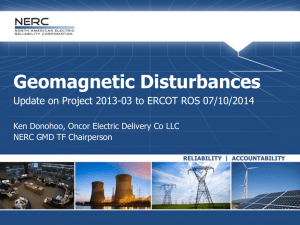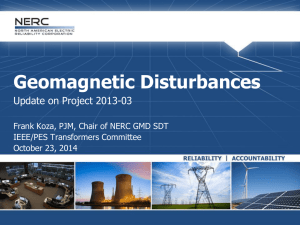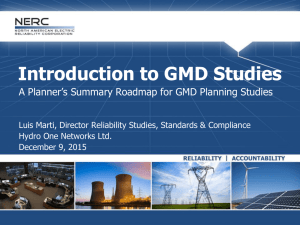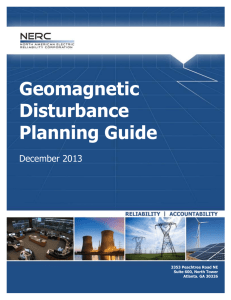GMD_standards_update_FRCC_june16
advertisement
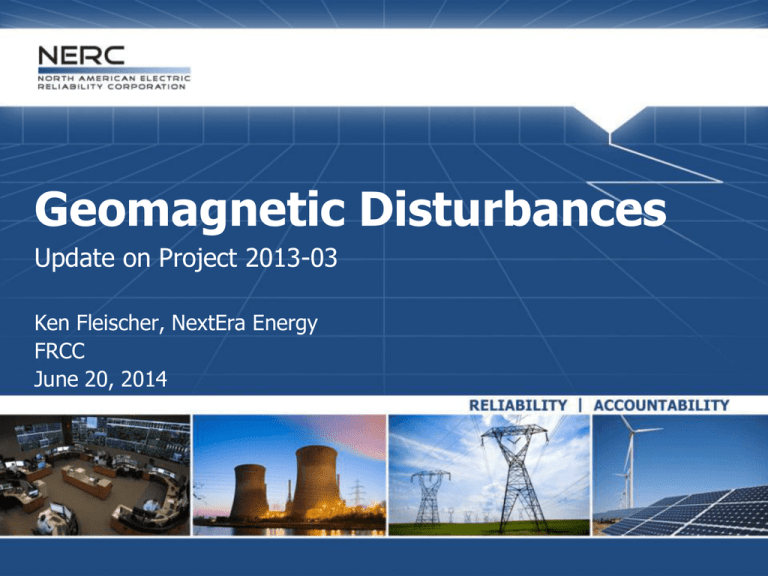
Geomagnetic Disturbances Update on Project 2013-03 Ken Fleischer, NextEra Energy FRCC June 20, 2014 Potential Impacts on the Power System Geomagneticallyinduced currents (GIC) can cause: • Increased reactive power consumption • Transformer heating • Protection System misoperation 2 RELIABILITY | ACCOUNTABILITY TPL-007 Summary • Requires a GMD Vulnerability Assessment of the system for its ability to withstand a Benchmark GMD Event without causing a wide area blackout, voltage collapse, or damage to transformers, once every 5 years. Applicability: PCs,TPs • Requires a Transformer thermal impact assessment to ensure that all high-side, wye grounded transformers connected at 200kV or higher will not overheat based on the Benchmark GMD Event Applicability: GOs, TOs 3 RELIABILITY | ACCOUNTABILITY Changes Made to the Draft Standard • Reordered the requirements Comments indicated some confusion as to the order in which the requirements would be executed • Established a floor of 15 Amperes for Transformer Thermal Assessment If calculated GIC is 15A or less, no further transformer thermal analysis is required Technical justification: Continuous 15A exposure does not result in temperatures of concern, based on transformer testing • Revised Implementation Plan Moved earlier implementation steps (determine responsibilities, build models) Maintained 4 year timeline to develop Corrective Action Plan 4 RELIABILITY | ACCOUNTABILITY Suggested Changes NOT Included • Include RCs as an applicable entity But, RCs included as a recipient of the analyses for information and for situational awareness • Establish an exemption for lower latitude systems Benchmark definition includes adjustment factors for earth conductivity and geomagnetic latitude, but assessment is required Technical justification not available at this point • Change the Benchmark GMD Event geoelectric field magnitude 5 RELIABILITY | ACCOUNTABILITY Comments on the GMD Benchmark • Benchmark geoelectric field is too low Earlier work by GMD TF had peak fields of 20V/km or more “Spatial averaging” technique is not documented in peer-reviewed technical papers • Benchmark geoelectric field is too high Statistical analysis calculates out to a field of 5.8V/km Visual extrapolation implies a field of 3-8V/km (why not 3V/km or 5.8V/km?) 6 RELIABILITY | ACCOUNTABILITY GMD Benchmark Geoelectric Field Epeak = Ebenchmark x α x β (in V/km) where, Epeak = Ebenchmark = α = β = 7 Benchmark geoelectric field magnitude at System location Benchmark geoelectric field magnitude at reference location (60° N geomagnetic latitude, resistive ground model) Factor adjustment for geomagnetic latitude Factor adjustment for regional Earth conductivity model RELIABILITY | ACCOUNTABILITY Reference Geoelectric Field Amplitude 1-in-100 Year Occurrence 3-8 V/km at 60⁰ N geomagnetic latitude 8 V/km to be conservative Statistical occurrence of spatially averaged high-latitude geoelectric field amplitudes from IMAGE magnetometer data (1993 – 2013) 8 RELIABILITY | ACCOUNTABILITY Response to the Benchmark Comments • Statistical analyses (GMD Task Force and standards project) are based on the same data • Spatial averaging of geomagnetic observation data is a appropriate for assessing wide-area impacts • Benchmark is conservatively “high” to provide for margin, given the uncertainties associated with these types of calculations 9 RELIABILITY | ACCOUNTABILITY Ground Conductivity Update • USGS is reviewing published references for Florida • Interim guidance in revised draft CP-2 EPRI (Fernberg) Report - 2013 10 Oak Ridge Lab Report - 2010 RELIABILITY | ACCOUNTABILITY Integrated View of the GMD Assessment Process Geomagnetic Field B(t ) Potential Mitigation Measures Geoelectric Field Earth E(t ) Conductivity Model dc System Model GIC Transformer Model ( Electrical) GIC(t) 11 vars Power Flow Analysis Transformer Model ( Thermal) Bus Voltages Line Loading & var Reserves Temp(t) Fail Assessment Criteria Pass Operating Procedures and Mitigation Measures (if needed) Hot Spot . Temp RELIABILITY | ACCOUNTABILITY Implementation Plan Date of Approval 12 14 Months 36 Months •R2 •System Models •R6 •Thermal Assessment 60 Days 18 Months 48 Months •R1 •Identify Responsibilities •R5 •GIC Flow Information •R3, R4, and R7 •GMD Assessment •Corrective Action Plan RELIABILITY | ACCOUNTABILITY Next Steps • Formal Comment and Initial Ballot— June 13 – July 30, 2014 Industry Webinar June 26, 2014 Technical Conference July 17, 2014 • SDT reviews ballot results and comments—August, 2014 • Post for a second ballot—August, 2014 • Seek NERC Board adoption at November meeting • Submit to FERC ahead of January 2015 deadline 13 RELIABILITY | ACCOUNTABILITY Resources • Project page: http://www.nerc.com/pa/Stand/Pages/Project2013-03-Geomagnetic-Disturbance-Mitigation.aspx 14 RELIABILITY | ACCOUNTABILITY 15 RELIABILITY | ACCOUNTABILITY
